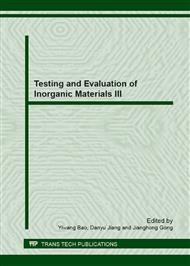p.295
p.299
p.304
p.310
p.316
p.321
p.326
p.330
p.334
Properties Analysis of Corundum Castables and Corundum MA Spinel Castables
Abstract:
Due to its excellent properties and good workability, castables is widely used in metallurgical field especially in steel and nonferrous metallurgical industry. In this article, we mainly had a comparative analysis of corundum castables and corundum MA spinel castables with 15% and 30% MA spinel addition . The physical and mechanical properties such as the bulk density, apparent porosity, cold modulus of rupture, cold crushing strength and thermal shock resistance of samples were studied after different temperature heating treated at 110°C×24h, 1100°C×3h and 1400°C×3h, respectively. The thermal conductivity of different samples at 750°C were tested by plate heat conduction method, phase composition and microstructure of samples with 15% MA spinel addition after different temperature heating treated were tested by XRD and SEM respectively. The results showed that: the properties of corundum MA spinel castables with 15% MA spinel addition is relatively good, the corundum castables take second place, samples with 30% MA spinel addition showed the worst performance among the three. After the heating treatment at 1400°C×3h, the CCS and CMOR of the samples is higher than that of 110°C×24h and 1100°C×3h due to the CA6 formation. Coefficient of thermal conductivity of the corundum-based castables at 750°C is relatively higher compared with that of 15% and 30% MA addition, reaches at 1.260w/ (m.k).
Info:
Periodical:
Pages:
316-320
Citation:
Online since:
March 2013
Authors:
Keywords:
Price:
Сopyright:
© 2013 Trans Tech Publications Ltd. All Rights Reserved
Share:
Citation:


